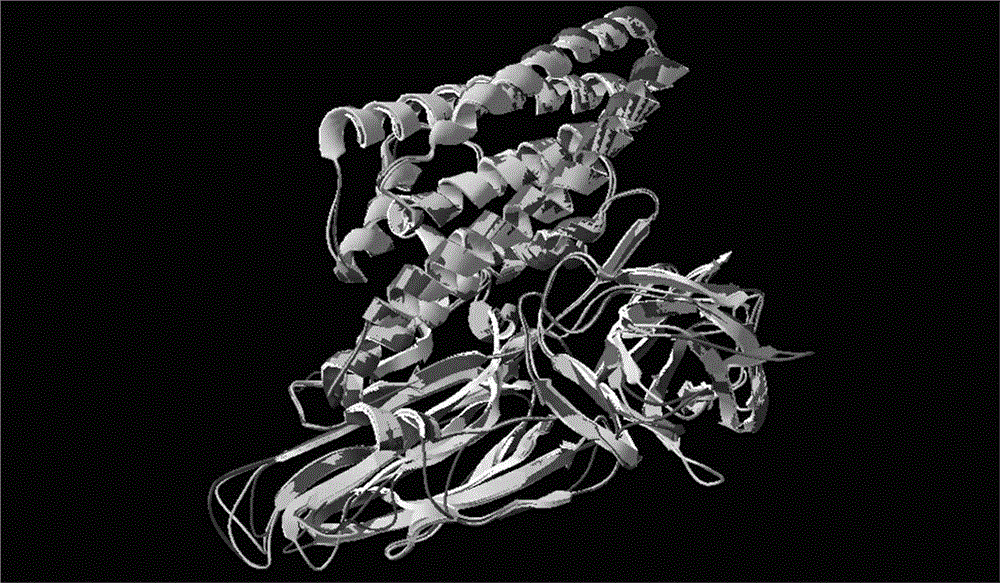Antibody for broad-spectrum detection of Bt Cry1 toxoids as well as preparation method and application thereof
A technology of toxoids and antibodies, applied in the field of biochemistry
- Summary
- Abstract
- Description
- Claims
- Application Information
AI Technical Summary
Problems solved by technology
Method used
Image
Examples
preparation example Construction
[0022] The preparation method that relates to solution in the embodiment:
[0023] (1) Saturated ammonium sulfate solution:
[0024] Add 500g of ammonium sulfate to 500mL of distilled water, heat until completely dissolved; overnight at room temperature, precipitate crystals and leave them in the bottle, take the required amount before use, and adjust the pH to 7.8 with NaOH;
[0025] (2) Acetate buffer (0.06mol / LpH4.8):
[0026] Dissolve 0.29g of NaAc and 0.141mL of HAc in deionized water, dilute to 100mL, and adjust the pH value to 4.8.
[0027] (3) Phosphate buffered saline (PBS, pH7.4):
[0028] NaCl8.0g, KCl0.2g, NaCl 2 HPO4·12H 2 O2.9g, KH 2 PO 4 0.2g, add distilled water to make up to 1L;
[0029] (4) Washing solution (PBST): PBS containing 0.05% Tween;
[0030] (5) Blocking solution (MPBS): PBS containing 3% skimmed milk powder;
[0031] (6) Citrate buffer (CPBS, substrate buffer, pH5.5):
[0032] C 6 h 7 o 8 (citric acid) 21g, Na 2 HPO 4 12H 2 O71.6g, ...
Embodiment 1
[0046] Embodiment 1 prepares monoclonal antibody
[0047] (1) The amino acid sequences of Cry1Aa, Cry1Ab, Cry1Ac, Cry1B, Cry1C and Cry1F were retrieved in the GenBank database;
[0048] (2) Use DNAMAN software to compare the amino acid sequences of Cry1Aa, Cry1Ab, Cry1Ac, Cry1B, Cry1C and Cry1F to find out the most similar peptide sequences. The amino acid sequence comparison results of the selected peptides are as follows: figure 1 shown;
[0049] (3) Use DNAStar software to find out the parts with strong antigenicity and hydrophilicity in Cry1Aa, Cry1Ab, Cry1Ac, Cry1B, Cry1C and Cry1F. The antigenicity and hydrophilicity analysis results of the peptides are as follows: figure 2 shown;
[0050] (4) Finally, use the SWISS-MODEL website to construct the three-dimensional structure models of the six toxins Cry1Aa, Cry1Ab, Cry1Ac, Cry1B, Cry1C and Cry1F, and use the Swiss-PdbViewer4.1.0 software to analyze the three-dimensional structure models to find out the three-dimensional...
Embodiment 2
[0065] Example 2 Antibody Sensitivity Detection
[0066] (1) Inoculate the hybridoma cell line obtained in Example 1 into mice, and prepare ascites by in vivo induction method. The specific steps are as follows:
[0067] The well-grown hybridoma cells were gently blown off, collected by centrifugation, resuspended in RPMI-1640 basal culture medium and counted, and the number of cells was controlled at 1-2×10 6 Within the range of cells / mL, intraperitoneally inject mice that have been pretreated with paraffin oil in advance, and inject 2 mice per cell line, 0.5 mL per mouse. Closely observe the health status of the mice and signs of ascites. About 10 days later, the abdomen of the mice began to expand.
[0068] Centrifuge the collected ascites at 5000 rpm for 10 min at 4°C to remove fat and blood cells, add an equal amount of glycerol to the centrifuged ascites, and store it in a -20°C refrigerator.
[0069] (2) Purify the ascites obtained in step (1) by octanoic acid-ammoniu...
PUM
 Login to View More
Login to View More Abstract
Description
Claims
Application Information
 Login to View More
Login to View More - R&D
- Intellectual Property
- Life Sciences
- Materials
- Tech Scout
- Unparalleled Data Quality
- Higher Quality Content
- 60% Fewer Hallucinations
Browse by: Latest US Patents, China's latest patents, Technical Efficacy Thesaurus, Application Domain, Technology Topic, Popular Technical Reports.
© 2025 PatSnap. All rights reserved.Legal|Privacy policy|Modern Slavery Act Transparency Statement|Sitemap|About US| Contact US: help@patsnap.com



